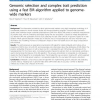BMCBI
2010
13 years 11 months ago
2010
Background: Pathway-targeted or low-density arrays are used more and more frequently in biomedical research, particularly those arrays that are based on quantitative real-time PCR...
BMCBI
2010
13 years 11 months ago
2010
Background: The information provided by dense genome-wide markers using high throughput technology is of considerable potential in human disease studies and livestock breeding pro...
BMCBI
2010
13 years 11 months ago
2010
Background: In the study of cancer genomics, gene expression microarrays, which measure thousands of genes in a single assay, provide abundant information for the investigation of...
BMCBI
2010
13 years 11 months ago
2010
Background: High throughput sequencing has become an important technology for studying expression levels in many types of genomic, and particularly transcriptomic, data. One key w...
BMCBI
2010
13 years 11 months ago
2010
Background: In microarray gene expression profiling experiments, differentially expressed genes (DEGs) are detected from among tens of thousands of genes on an array using statist...
BMCBI
2010
13 years 11 months ago
2010
We study the shape of coverage functions resulting from the sequencing of random genome fragments, and show that they can be described by Galton-Watson trees. This extends standar...
BMCBI
2010
13 years 11 months ago
2010
BMCBI
2010
13 years 11 months ago
2010
Background: Signal transduction events often involve transient, yet specific, interactions between structurally conserved protein domains and polypeptide sequences in target prote...
BMCBI
2010
13 years 11 months ago
2010
Background: Datasets generated on deep-sequencing platforms have been deposited in various public repositories such as the Gene Expression Omnibus (GEO), Sequence Read Archive (SR...
BMCBI
2010
13 years 11 months ago
2010
Background: A molecular network perspective forms the foundation of systems biology. A common practice in analyzing protein-protein interaction (PPI) networks is to perform networ...



